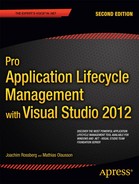PART 7
![]()
Team Foundation Server
In the final part of this book we look a little more at TFS itself. To appreciate what options we have when it comes to deploying TFS in our organization we need to have an understanding of the architecture of TFS. Given that, we can carry on with planning the actual deployment. Do we upgrade from an earlier version? Do we complete a clean install? Do we need to distribute TFS among several servers to handle a large workload? These topics are covered here.
Chapter 32 looks at how reporting works in TFS. This is essential—especially if we need to perform customizations for our organizational needs.
The final two chapters are very interesting indeed. We discuss how to use TFS together with Eclipse (just to mention one development tool that is not .NET). Using Team Explorer Everywhere we can access version control, work items, and many other aspects of TFS from our Eclipse environment, even from Mac OS X. This is useful if we work in an organization with development on many platforms.
We finish the book by covering TFS in the cloud. Microsoft has a cloud-based version of TFS running on Windows Azure. At the time of writing this is still in prerelease and by invitation only, but it looks really good. This could be a perfect solution when we do not want to spend time, money, and effort on maintaining our own TFS environment on our own premises.
